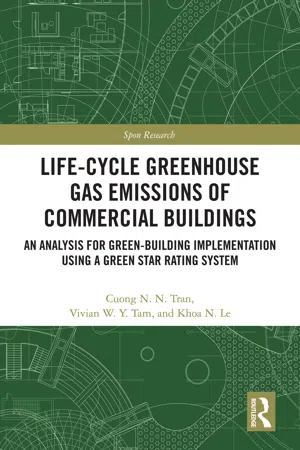
Life-Cycle Greenhouse Gas Emissions of Commercial Buildings
An Analysis for Green-Building Implementation Using A Green Star Rating System
- 176 pages
- English
- ePUB (mobile friendly)
- Available on iOS & Android
Life-Cycle Greenhouse Gas Emissions of Commercial Buildings
An Analysis for Green-Building Implementation Using A Green Star Rating System
About this book
This book develops a model to evaluate and assess life-cycle greenhouse gas emissions based on typical Australian commercial building design options. It also draws comparisons between some of the many green building rating tools that have been developed worldwide to support sustainable development. These include: Leadership in Energy and Environmental Design (LEED) by the United States Green Building Council (USGBC), Building Research Establishment Environmental Assessment Method (BREEAM) by the Building Research Establishment, Comprehensive Assessment System for Building Environmental Efficiency (CASBEE) by the Japanese Sustainable Building Consortium, and Green Star Environmental Rating System by the Green Building Council of Australia.
Life-cycle assessment (LCA), life-cycle energy consumption, and life-cycle greenhouse gas emissions form the three pillars of life-cycle studies, which have been used to evaluate environmental impacts of building construction. Assessment of the life-cycle greenhouse gas emissions of buildings is one of the significant obstacles in evaluating green building performance. This book explains the methodology for achieving points for the categories associated with reduction of greenhouse gas emissions in the Australian Green Star rating system. The model for the assessment uses GaBi 8.7 platform along with Visual Basic in Microsoft Excel and shows the relationship between the building's energy consumption and greenhouse gas emissions released during the lifetime of the building. The data gathered in the book also illustrates that the green building design and specifications are becoming more popular and are being increasingly utilized in Australia. This book is important reading for anyone interested in sustainable construction, green design and buildings and LCA tools.
Frequently asked questions
- Essential is ideal for learners and professionals who enjoy exploring a wide range of subjects. Access the Essential Library with 800,000+ trusted titles and best-sellers across business, personal growth, and the humanities. Includes unlimited reading time and Standard Read Aloud voice.
- Complete: Perfect for advanced learners and researchers needing full, unrestricted access. Unlock 1.4M+ books across hundreds of subjects, including academic and specialized titles. The Complete Plan also includes advanced features like Premium Read Aloud and Research Assistant.
Please note we cannot support devices running on iOS 13 and Android 7 or earlier. Learn more about using the app.
Information
1
Introduction
1.1 Background
1.2 Research aim and objectives
- Critical reviews of sustainable development, green building rating tools worldwide, and techniques to analyze life-cycle GHG emissions in green buildings, which include the following:
- Reviewing sustainable development goals and green building concepts.
- Reviewing the development of life-cycle assessment in the construction sector.
- Reviewing green building rating tools from global and Australian perspectives.
- Examining model technique development in life-cycle assessment.
- Analyzing life-cycle GHG emissions assessment in green buildings.
- Reviewing and classifying the Green Star – Design & As Built rating tool and describing the methodology to develop a model for GHG emissions assessment:
- Reviewing the Green Star design rating tool in Australia and determining the credits in this rating tool related to life-cycle GHG emissions.
- Analyzing the process of model development for the life-cycle GHG emissions assessment.
- Discussing environmental impacts of model parameters:
- Discussing the environmental impact of commercial buildings’ envelopes with respect to climate zones in Australia.
- Discussing the environmental impacts of materials for green buildings.
- Validating the life-cycle GHG emissions assessment model and determining optimal options for achieving credit points in the Green Star rating tool for Australian commercial buildings by employing case studies of buildings that were awarded the Green Star certificate.
1.3 The significance of the book
1.4 Research methodology

1.5 Scope of the book
1.6 Book structure
Table of contents
- Cover
- Half Title
- Series Page
- Title Page
- Copyright Page
- Contents
- List of tables
- List of figures
- List of equations
- List of acronyms and abbreviations
- Abstract
- 1 Introduction
- 2 Green building: a concept to achieve sustainable development goals
- 3 Classification of Green Star credits and model development for the reduction of greenhouse gas emissions
- 4 Environmental impacts on the model’s parameters
- 5 Life-cycle greenhouse gas emissions: case studies and validation
- 6 Conclusion
- References
- Index